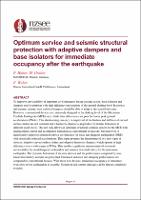Optimum service and seismic structural protection with adaptive dampers and base isolators for immediate occupancy after the earthquake

Download
Date
2023-04-19Authors
Huber, Peter
Weber, Felix
Gruber, Marcel
Metadata
Show full item recordAbstract
To improve serviceability of important civil structures during seismic action, base isolators and dampers need to perform with high efficiency independent of the ground shaking level. In service and seismic actions, base isolators/dampers should be able to adapt to the actual load cases. However, conventional devices are commonly designed to the shaking level of the Maximum Credible Earthquake (MCE) only, while their efficiencies are poor for lower peak ground accelerations (PGAs). This shortcoming can only be improved, if the friction and stiffness of curved surface sliders are not constant and if hysteretic dampers can produce hysteretic behaviour at different yield levels. This not only allows an optimum structural isolation system for the MCE with displacement control and acceleration limitation as conventional devices do, but moreover, it significantly improves structural service performance for weak and frequent earthquakes (DBE) with drastically reduced accelerations. This paper presents the functioning of two new types of devices: adaptive curved surface sliders and adaptive hysteretic dampers which operate at high efficiency over a wide range of PGAs. This enables significant enhancement of structural serviceability for weak/frequent earthquakes and ensures structural safety for the maximum earthquake. The dynamic behaviour of the new devices and the performance computed by non-linear time history analysis are presented. Enhanced isolation and damping performances are compared to conventional devices. With these new devices, immediate occupancy of structures even after severe earthquakes is possible. Structural and content damages can be almost completely avoided.
